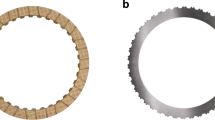Abstract
Wet clutches are used in automatic transmissions to enable gear changes and also to reduce energy loss in the torque converter. These friction devices are susceptible to stick–slip effects, which result in the vehicle giving an unsteady ride. Stick–slip effects can be avoided by ensuring the wet clutch and lubricant combination produces a friction coefficient that increases with sliding speed. Although wet clutches have been studied throughout the industry for many decades, the mechanism of the generated friction is still not fully understood. It is known that, because of the fibrous nature and thus very large roughness of friction material, the overall contact between clutch plates actually consists of many small, independent, contact units, which are the sites of the generated friction. Some authors have suggested that a temperature rise due to friction either at these contact units or of the overall clutch plate may be important in controlling friction behaviour. In this study, the flash temperatures at the contact units formed in the wet clutch contact have been measured using an infrared camera. Three friction materials have been tested. It was found that measured flash temperature in a pure sliding system similar to that present in a slipping clutch remain well below 5 °C, and are therefore unlikely to play a major role in the observed friction-speed dependency of slipping wet clutches at speeds below 2 m/s.













Similar content being viewed by others
References
Sanda, S., Nagasawa, Y., Suzuki, A., Hayashi, K., Itoh, H.: Mechanism of friction of wet clutch with paper based facings Part 1 observation and modeling of facing surface during engagement. Proc Int Trib Conf, Yokohoma (1995), pp. 1519–1524
Eguchi, S., Yamamoto, T.: Shear characteristics of a boundary film for a paper-based wet friction material: friction and real contact area measurement. Tribol. Int. 38, 327–335 (2005)
Otani, C., Kimura, Y.: Analysis of the real contact area of a paper-based wet friction material. Jpn. J. Tribol. 39(12), 1487–1494 (1994)
Ingram, M., Spikes, H., Noles, J., Watts, R.: Contact properties of a wet clutch friction material. Tribol. Int. 43(4), 815–821 (2010)
Jang, J.Y., Khonsari, M.M.: Thermal characteristics of a wet clutch. Trans. ASME 121, 610–617 (1999)
Cameron, T.M., McCombs, T., Tersigni, S., Jao, T.C.: Flash temperatures in clutches. SAE Paper 2005-01-3890 (2005)
Natsumeda, S., Miyoshi, T.: Numerical simulation of engagement of paper based wet clutch facing. ASME J. Tribol. 116, 232–237 (1994)
Berger, E.J., Sadegi, F., Krousgrill, C.M.: Finite element modelling of engagement of rough and grooved wet clutches. ASME J. Tribol. 118, 137–146 (1996)
Yang, Y., Lam, R.C., Chen, Y.F., Yabe, H.: Modelling of heat transfer and fluid hydrodynamics for a multidisc wet clutch. SAE Paper 950898 (1995)
Eguchi, M., Kuwahara, Y., Yamamoto, T.: Study on origin of friction of a paper-based facing for a wet clutch: consideration based on analysis of real contact area by electrical contact resistance method. Jpn. J. Tribol. 39(12), 1553–1565 (1994)
Marklund, P., Larsson, R.: Wet clutch under limited slip conditions—simplified testing and simulation. Proc. IMechE. J. 221, 545–551 (2007)
Ohtani, H., Hartley, R.J., Stinnett, D.W.: Prediction of anti-shudder properties of automatic transmission fluids using a modified SAE No. 2 machine. SAE Paper 940821 (1994)
Kearsey, A., Wagner, D.: Carbon fiber for wet friction applications. SAE Paper 972754 (1997)
Lawrence, G., Mace, G., Bowler, N., Goddard, G., Morrey, D.: Measurement of the interfacial plate temperatures with a carbon clutch, and determination of effects upon its friction characteristics. SAE Paper 2006-01-3634 (2006)
Chrisope, D.R., Stinnett, D.W., Hartley, R.J.: Friction retention and thermal decomposition of fluid additives in wet clutch system. Proceedings of the TAE Tribology Colloquium Esslingen, Germany (1992)
Floquet, A., Play, D.: Contact temperatures in dry bearings: three dimensional theory and verification. J. Lubr. Technol. 103, 243–252 (1981)
Osanai, H., Ohnuma, H., Kato, K.: Temperature measurement and durability of the frictional surfaces of paper-based wet frictional materials. Jpn. J. Tribol. 39(12), 1471–1478 (1994)
Holgerson, M.: Apparatus for measurement of engagement characteristics of a wet clutch. Wear 213, 140–147 (1997)
Marx, D.T., Policandriotes, T., Zhang, S., Scott, J., Dinwiddie, R.B., Wang, H.: Measurement of interfacial temperatures during testing of a subscale aircraft brake. J. Phys. D 34, 976–984 (2001)
Reddyhoff, T., Spikes, H.A., Olver, A.V.: Improved temperature mMapping of EHL contacts. Proc. I.MechE. J 223, 1165–1177 (2009)
Reddyhoff, T., Spikes, H.A., Olver, A.V.: Compression heating and cooling in elastohydrodynamic contacts. Tribol. Lett. 36, 69–80 (2009)
Jaeger, J.C.: Moving sources of heat and temperature at sliding contacts. Proc. R. Soc. NSW 76, 203–224 (1942)
Blok, H.: Theoretical study of temperature rise at surfaces of actual contact under oiliness lubricating conditions. Inst. Mech. Eng. General Discuss. Lubr. 2, 222–235 (1937)
Greenwood, J.A.: An interpolation formula for flash temperatures. Wear 150, 153–158 (1991)
Archard, J.F.: The temperature of rubbing surfaces. Wear 2, 438–455 (1958/1959)
Fairbank, D., Maruo, K., Du, S., Newcomb, T.: ATF additive effects on hot spot formation in wet clutches. SAE Paper 2001-01-3594 (2001)
Author information
Authors and Affiliations
Corresponding author
Rights and permissions
About this article
Cite this article
Ingram, M., Reddyhoff, T. & Spikes, H.A. Thermal Behaviour of a Slipping Wet Clutch Contact. Tribol Lett 41, 23–32 (2011). https://doi.org/10.1007/s11249-010-9669-2
Received:
Accepted:
Published:
Issue Date:
DOI: https://doi.org/10.1007/s11249-010-9669-2




